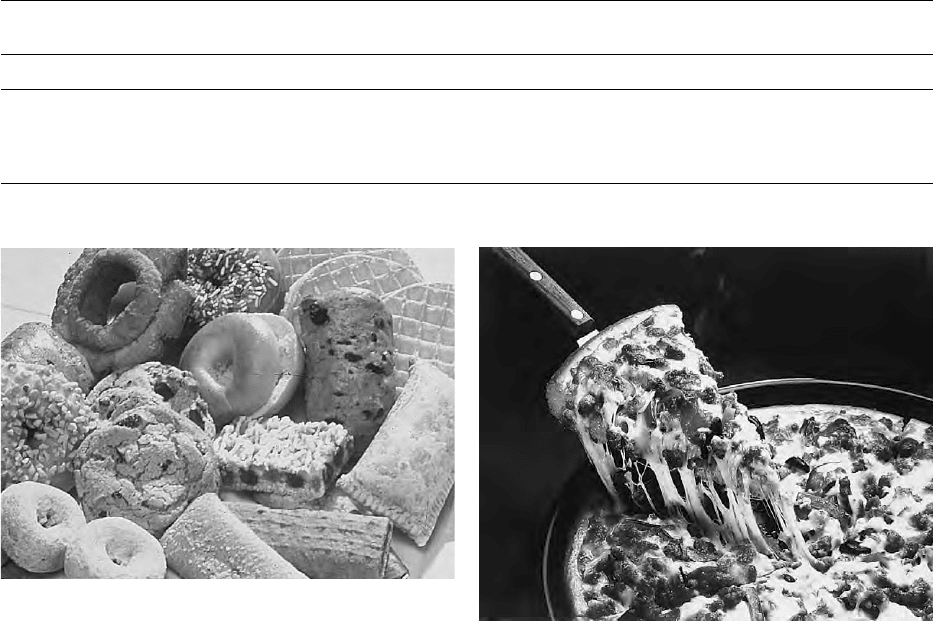Caballero B. (ed.) Encyclopaedia of Food Science, Food Technology and Nutrition. Ten-Volume Set
Подождите немного. Документ загружается.


of drying require the transfer of moisture from the
center to the surface of the particle, and this is a much
slower process.
0020 Pneumatic-conveying ring driers and attrition
driers are also used for drying casein. These employ
inline milling and tend to produce finer casein
products than those dried in fluid-bed driers.
Cooling, Tempering, Milling, Sifting, Blending,
Packing
0021 Casein that is produced using fluid-bed driers is warm
and soft and unsuitable for grinding immediately in
some mills such as roller mills. Consequently, the
casein may be cooled and then transferred to
tempering bins where equilibration of moisture can
occur in and between all the particles during a period
of 8–24 h.
0022 The casein may then be ground and sieved,
using multideck, gyrating screens, into various par-
ticle sizes, usually < 600 mm. Very fine casein (e.g.
< 150 mm) is generally produced using pin mills.
0023 Following blending of the ground casein, it is
packed into multiwall paper bags equipped with
plastic liners and stored. The typical composition of
acid casein is shown in Table 1.
Rennet Casein
Action of Chymosin
0024 Casein may also be precipitated from milk by the
action of a proteolytic enzyme, such as chymosin,
which is present in calf rennet. Chymosin (and other
enzymes from animal or microbial sources that cause
milk to clot) splits off a portion of the k-casein (re-
ferred to as glycomacropeptide or GMP) from the
micelles. As a result, the micelles are no longer
stable in the presence of calcium ions and form a
three-dimensional gel. This process is essential in the
production of most types of cheese.
Clotting of Skimmed Milk
0025Pasteurized skimmed milk at a temperature of 29
C
(or lower) is mixed with calf rennet (or other milk-
clotting enzyme) in the approximate ratio (by
volume) of 1:7500 rennet to the milk. If a lower
setting temperature is used, renneting time must be
correspondingly increased. It is also possible to
reduce the quantity of rennet added under these con-
ditions and consequently allow a longer time for
rennet action to occur.
Cooking
0026The usual technique for cooking rennet casein in-
volves the injection of steam into a cooking line of
clotted milk pumped from a vat. However, the vat
cooking technique (similar to that used in cheese
manufacture) is also practiced in some countries.
The cooking temperature used in making rennet
casein usually varies from about 50 to 60
C.
0027Dewheying, washing, dewatering, and drying of
the curd then proceed in a manner similar to that
used for acid casein, and the dried casein is also
treated as outlined previously.
0028Where indirect cooking of rennet casein is used, a
tubular heat exchanger may be used to cook the curds
and whey to a temperature similar to that used in the
direct cook (steam injection) process. Other process-
ing steps are similar to those described above but no
acidulation step is required after cooking of the
rennet casein.
0029The typical composition of rennet casein is shown
in Table 1.
tbl0001 Table 1 Typical composition and properties of casein products
Component Acid casein Rennet casein Sodium caseinate (spray dried)
Composition Amount per 100 g
Moisture (g) 11.5 11.5 4.5
Fat (g) 1.1 0.4 1.0
Protein (g) (nitrogen 6.38) 86.2 81.3 92.0
Ash (g) 1.8 8.2 3.6
Lactose (g) 0.1 0.1 0.1
Amount per 1 kg
Copper (mg) 2 2 2
Lead (mg) < 1 < 1 < 1
Iron (mg) 5–20 5 5–10
Physical properties
Color Creamy white Creamy white White
Flavor Bland, clean Bland, clean Bland, clean
Solubility in water Insoluble Insoluble Soluble
946 CASEIN AND CASEINATES/Methods of Manufacture

Coprecipitates
0030 Coprecipitates are combinations of casein and whey
proteins that are coprecipitated from heated (skimmed)
milk. When milk is heated to a temperature greater
than 70
C, some of the whey proteins are heat-
denatured and may interact with some of the caseins.
When a casein precipitant (such as acid or calcium
chloride) is added to the heated milk, the casein and
whey proteins coprecipitate together. Depending on the
pH of precipitation (which may vary from 6.6 to 4.5),
the coprecipitate will contain different quantities of
calcium (high-calcium at pH 6.6 to low-calcium at
pH 4.5). As whey proteins have a higher nutritional
value than casein (as measured by several different
biological and chemical techniques), coprecipitates
also have an enhanced nutritional value compared
with casein. The yield of coprecipitate from skimmed
milk is usually 5–20% greater than that of acid casein.
Caseinates
0031 Caseinates are produced by the neutralization of acid
casein with alkali. All caseinates are substantially
water-soluble and are typically prepared as a
solution of about 20% solids prior to spray drying.
Roller-dried caseinates may be prepared from more
concentrated solutions. It is also possible to prepare
granular, partly soluble, or semidispersible forms of
caseinate in which the casein and alkali have only
partly reacted. Sodium caseinate is the most common
form of this class of product and is prepared by
mixing a solution of sodium hydroxide, bicarbonate,
or carbonate with acid casein curd or dry acid casein
that has been suspended in water and then drying the
resultant solution (Figure 2). The dried powder
dissolves completely in water to produce a viscous,
sticky, straw-colored solution.
0032Calcium caseinate, on the other hand, produces
a thin, opaque, white colloidal dispersion in water,
similar in appearance to milk. Other caseinates,
such as those of potassium and ammonium, are simi-
lar in general properties to sodium caseinate. Magne-
sium caseinate has properties that are intermediate
between those of sodium and calcium caseinates.
However, relatively insignificant commercial quan-
tities of these products are manufactured at the
present time.
Casein dewatering
Casein mincer
Sodium hydroxide
Curd−alkali mixer
D
C
Colloid
mill
Water
(40 8C)
F1 F2
pH
Jacketed vats
pH recording
and control
Heat
exchanger
Balance
tank
Viscometer and
viscosity control
Hot water
To spray drier
H
Sodium hydroxide solution
supply tank
fig0002 Figure 2 Suggested plant layout for dissolving casein for sodium caseinate manufacture. Dewatered casein curd is minced, mixed
with water, and finely milled in a colloid mill (C). The curd–water slurry is then mixed (D) with dilute sodium hydroxide solution and
transferred to the first of two jacketed dissolving vats (F
1
), each equipped with an agitator. The sodium caseinate solution is
subsequently pumped from the second dissolving vat (F
2
) and extra alkali is added, if necessary. The solution is heated by means
of a tubular heat exchanger (H) and then pumped via a balance tank to the spray (or roller) drier for drying. The viscosity of the solution
may be monitored and reduced, if necessary, by addition of hot water. From Southward CR (1985) Manufacture and applications of
edible casein products. I. Manufacture and properties. New Zealand Journal of Dairy Science and Technology 20: 79–101, with permission.
CASEIN AND CASEINATES/Methods of Manufacture 947

0033 The typical composition of sodium caseinate is
shown in Table 1. Acid (low-calcium) coprecipitates
can be dissolved in alkali in a similar manner to that
used for acid casein. Both rennet casein and high-
calcium coprecipitate (precipitated at a pH of 6 or
greater) are usually rendered soluble by means of com-
plex phosphates, such as sodium tripolyphosphate, to
produce translucent solutions with a viscosity some-
what higher than that of the corresponding caseinates.
0034 In the great majority of applications, in both edible
and technical (nonfood) uses, casein must first be
made soluble before it can be used in its final applica-
tion. Although some users convert the dry casein to
caseinate themselves, others tend to purchase the case-
inate directly from the producer (often as a ‘fresh-
curd’ caseinate). For applications in foods. (See Casein
and Caseinates: Uses in the Food Industry.)
See also: Casein and Caseinates: Uses in the Food
Industry; Cheeses: Starter Cultures Employed in Cheese-
making; Chemistry of Gel Formation; Drying: Fluidized-
bed Drying; Lactic Acid Bacteria; Pasteurization:
Principles; Starter Cultures; Whey and Whey Powders:
Production and Uses; Protein Concentrates and Fractions;
Fermentation of Whey
Further Reading
Australian Society of Dairy Technology (1972) Casein
Manual. Parkville, Melbourne: Australian Society of
Dairy Technology.
Farrell HM Jr (1988) Physical equilibria: proteins. In: Wong
NP, Jenness R, Keeney M and Marth EH (eds) Funda-
mentals of Dairy Chemistry, 3rd edn, pp. 461–510. New
York: Van Nostrand Reinhold.
Muller LL (1971) Manufacture and uses of casein and
coprecipitates: a review. Dairy Science Abstracts 33:
659–674.
Muller LL (1982) Manufacture of casein, caseinates and
coprecipitates. In: Fox PF (ed) Developments in Dairy
Chemistry, vol. 1. Proteins, pp. 315–337. London:
Applied Science.
Mulvihill DM (1989) Caseins and caseinates: manufacture.
In: Fox PF (ed) Developments in Dairy Chemistry, vol. 4,
Functional Milk Proteins, pp. 97–130. London: Elsevier
Applied Science.
Mulvihill DM (1992) Production, functional properties
and utilization of milk protein products. In: Fox PF
(ed) Advanced Dairy Chemistry, vol. 1, Proteins,
pp. 369–404. London: Elsevier Applied Science.
Southward CR (1985) Manufacture and applications of
edible casein products. I. Manufacture and properties.
New Zealand Journal of Dairy Science and Technology
20: 79–101.
Southward CR (1994) Utilization of milk components:
casein. In: Robinson RK (ed) Modern Dairy Technology,
2nd edn, vol. 1, Advances in Milk Processing, pp.
375–432. London: Chapman and Hall.
Southward CR and Walker NJ (1980) The manufacture and
industrial use of casein. New Zealand Journal of Dairy
Science and Technology 15: 201–217.
Spellacy JR (1953) Casein, Dried and Condensed Whey.
San Francisco, California: Lithotype Process.
Whitney RMcL (1988) Proteins of milk. In: Wong NP,
Jenness R, Keeney M and Marth EH (eds) Fundamentals
of Dairy Chemistry, 3rd edn, pp. 81–169. New York:
Van Nostrand Reinhold.
Uses in the Food Industry
C R Southward, Fonterra Research Centre,
Palmerston North, New Zealand
Copyright 2003, Elsevier Science Ltd. All Rights Reserved.
Introduction
0001Although casein, as it exists in milk, has been con-
sumed as ‘food’ for thousands of years, the extracted
form of casein had very little application in foods
prior to 1960. Instead, from early in the 20th century,
and in some cases before then, it was used as an
adhesive in wood glues and paper coating, and in
paints, fibers, plastics, and leather finishing. The
introduction of coffee whiteners and whipped top-
pings, in particular, by the food industry in the USA
during the 1960s played a significant part in the
establishment of casein products in foods. These
two product groups were based on vegetable fat and
contained casein in a water-soluble form (usually
sodium caseinate), together with carbohydrate, emul-
sifiers, and stabilizers. They were promoted as ‘non-
dairy’ foods. (As casein was derived from milk, it was
not considered to be a dairy product. Furthermore, it
had been classified as a chemical because of its long-
established use in nonfood technical applications in
adhesives, paints, etc., as described above.) Nondairy
coffee whiteners and whipped toppings were thus
presented as alternatives to the traditional dairy
products of milk, cream, and whipping cream. They
offered advantages of lower price (because the
(imported) raw materials from which they were
made were cheaper than the domestic milk solids
they were replacing), convenience, and shelf stability
(several of the products were sold in powder form).
Other nondairy products followed, many of them
containing casein, e.g., so-called imitation milks,
imitation cheese, and salad dressings. Food supple-
ments and dietary products were also produced and
a number of these were based on casein. This
article reviews the use and function of casein products
in food.
948 CASEIN AND CASEINATES/Uses in the Food Industry

General
0002 The main applications of casein products in foods,
together with their functions in such foods, are shown
in Table 1. As a high-quality protein, casein can pro-
vide nutrition in foods, although this is often not the
main reason for its use. It is frequently incorporated
into food products for its ability to impart so-called
‘functional’ properties of whipping, foaming, fat
emulsification, film formation, water binding, and
thickening. Consequently, casein can have a signifi-
cant effect on the texture or consistency of a food.
Animal Feeding and Pet Foods
0003 During the middle of the 20th century, many experi-
ments were undertaken in the USA and, to a lesser
extent, in Europe and elsewhere, to determine the
effect of feeding cows with iodine and iodinated
casein (sometimes referred to as ‘thyroprotein’)on
their nutrition and milk yield. A number of studies
suggested that milk yield was increased, but there was
sufficient conflicting evidence for the practice not to
be widely adopted. Extensive nutritional feeding
trials for ruminants were undertaken in the late
1960s and 1970s to determine the effect – on milk
production and wool growth, respectively – of feed-
ing ‘protected’ casein to cows and sheep. The casein
was protected by reaction with formaldehyde, which
prevented it from being broken down by the rumen
microflora. It could pass undigested to the abomasum
where the acidic conditions were able to promote the
digestion of the casein. These studies were also
extended to determine how the feeding of polyunsat-
urated oils, encapsulated in formalin-treated caseins,
to ruminants affects the quantity of polyunsaturated
fat in meat and milk. Again, however, this was not
adopted commercially.
0004Casein (generally in the form of sodium caseinate)
may be used as a nutritional supplement in pet foods
and calf milk replacers, and it has also been reported
as an ingredient in fish food. Some recent reports in
the literature indicate that casein can be used to pro-
duce novel textured pet foods, as well as the more
traditional nutritional foods.
Bakery Applications
0005The water-binding properties of casein (as well as
nutrition) are important for bakery applications in
which casein products are incorporated. Soluble
forms of casein (such as caseinates) tend to bind too
much water and may make some foods too sticky or
‘doughy.’ Accordingly, insoluble or partly soluble
casein products are often used, because these have
less water binding than the fully soluble caseinates.
Some bakery products that have been made with case-
ins include doughnuts, waffles, cake mixes, and
bread. A number of examples of the use of casein
products in bakery applications, taken from the
recent literature, are shown in Table 2. Figure 1 illus-
trates the use of casein products in biscotti.
Cheese-like Foods
0006Casein has been used as an extender and texture
modifier in processed cheese, and even to increase
the yield of cheese from cheese milk (e.g., in Europe).
However, the most significant use of casein in cheese
products has probably been in the production of
tbl0001 Table 1 Use and function of casein products in foods
Application Principal functions
Animal and pet foods Nutrition, binder for moisture and fat
Bakery products Nutrition, texture, water binding
Beverages, including soups Emulsifier, stabilizer, nutrition
Coffee whiteners and creamers Resistance to feathering, emulsifier
Confectionery Nutrition, texture
Cultured products Stabilizer, emulsifier, consistency, nutrition
Extruded snack foods Texture
High-fat powders and shortenings Emulsifier, whipping
Icecream, mousse, and desserts Whipping, foaming, emulsifier
Imitation cheese and other cheese-like foods Texture, emulsifier
Infant foods Nutrition
Instant breakfasts and dietary preparations Nutrition
Meat products Emulsifier, water binding
Pasta Nutrition, texture
Pharmaceutical products Nutrition, therapeutic, film formation
Spreads Texture, stabilizer
Whipped toppings Stabilizer, emulsifier
CASEIN AND CASEINATES/Uses in the Food Industry 949

so-called ‘imitation’ or synthetic cheese (often re-
ferred to as cheese analogs). This product, similar in
properties to processed cheese, is made from water,
casein (e.g., acid casein, rennet casein, or sodium or
calcium caseinate, singly or in mixtures), vegetable
fat, stabilizers, and emulsifiers. The food industry in
the USA was first to develop imitation cheese (at least
in name), which could be seen as a similar develop-
ment in the cheese industry to the much earlier pro-
duction of margarine as an ‘imitation’ butter. Just as
coffee whiteners and whipped toppings (and artificial
milks) were developed in the US food industry in the
1960s as cheaper and/or convenience foods to com-
pete with milk and cream (see elsewhere in this art-
icle), so imitation cheese appeared. The commercial
production of imitation cheese first occurred in the
USA in the early 1970s, and the quantity produced
grew, during a period of several years, to a maximum
of about 5% of the total cheese sales in the USA.
Imitation cheese found its application as a cheaper
alternative to natural cheese, particularly in fast-food
outlets, in frozen pizza and hamburgers, for instance.
Figure 2 illustrates the use of rennet casein in an
imitation Mozzarella cheese, used on a pizza. In con-
sideration of its nutritional properties, imitation
cheese was also approved for use in the American
school lunch program. The main function of the
casein product in this application is to provide the
required body and texture, with emulsification of fat,
as well as the melting properties of the finished cheese
in pizza. This last-named function is achieved by
careful formulation, using food acids and stabilizing
salts to achieve the correct pH and mineral balance in
the cheese that will cause it to melt during the cooking
of the pizza to provide the expected ‘stretch’ and
‘stringing’ properties required for pizza cheese. Al-
though the use of imitation cheese in the UK and
Japan has been mentioned in the literature, its main
area of commerical significance is in the USA.
0007Other applications of casein in the cheese food
industry include surface coating of whole cheese and
cheese granules, using the natural film-forming prop-
erties of casein products. Several examples of the use
of casein products in cheese-like foods, taken from
the recent literature, are shown in Table 3.
Beverages
Imitation Milks
0008In the USA, so-called ‘filled milk’, which contains
vegetable fat and skimmed milk solids, has been
tbl0002 Table 2 Use of casein products in bakery applications
Examples Casein productused % Use/functionof casein product
Bread Sodium caseinate 2–30 Emulsification
Glazing agent Casein, casein salt 5–15 Film formation
Blini (pancake) Sodium caseinate 2.9–5 Increased storage life, friability
High-protein wafer Casein 50 Texture, nutrition
fig0001 Figure 1 (see color plate 17) Biscotti, representing baked prod-
ucts that can be made using high-calcium milk protein. Courtesy
of NZMP (North America) Inc.
fig0002Figure 2 (see color plate 19) Pizza, representing the use of
imitation Mozzarella cheese that can be made using rennet
casein. Courtesy of NZMP (Wellington) Ltd.
950 CASEIN AND CASEINATES/Uses in the Food Industry

sold for many years. In the late 1960s and 1970s, a
new class of milk –‘imitation milk’–appeared on the
market. This contained vegetable fat and various
other ingredients, including protein as sodium or po-
tassium caseinate or from soy beans, and a carbohy-
drate source such as corn syrup solids. Artificial milks
were also reported in the UK and the USSR. The
lower cost of the ingredients and the absence of lac-
tose (for which some people show intolerance) were
no doubt significant factors in the establishment of
such products. However, concerns were voiced over
the generally lower nutritional quality (e.g., lack of
vitamins and minerals and, sometimes, lower protein
content) and often poorer flavor compared with
‘normal’ cows’ milk. Casein products have also been
used to fortify fresh milk, though this has occurred in
Europe rather than in North America.
0009 Several examples of the use of casein products in
beverages, taken from the recent literature, are shown
in Table 4.
Cream Liqueurs
0010 Casein, in the form of sodium caseinate, has found
application recently in cream liqueurs, especially in
the UK and the Irish Republic, where they have been,
apparently, one of the fastest-growing markets for
cream. Other ingredients include sugar, alcohol, and
trisodium citrate. In this application, the sodium
caseinate acts mainly as an emulsifier or emulsion
stabilizer.
Coffee Whiteners and Creamers
0011As shown in Table 1, the main functions of casein
(as sodium caseinate) in coffee whiteners are to
provide emulsification and to promote resistance
to ‘feathering.’ It has been claimed that sodium
caseinate (or other protein) also imparts body,
provides some whitening (though this is mainly
due to the fat) and improves flavor. Although both
liquid and dry (powdered) coffee whiteners have
been produced, the most popular by far appear to
be the latter because, as mentioned in the introduc-
tion to this article, they have the advantages of
being shelf-stable and convenient to use. In addi-
tion, the low price of the major ingredients (veget-
able fat and carbohydrate, usually as corn syrup
solids) compared with that of (US domestic)
milk solids makes coffee whitener an attractive
alternative to milk or cream. Figure 3 shows the use
of a coffee whitener that contains high-calcium milk
protein.
Soups, Gravies, etc.
0012When casein products are used in soups, their pur-
pose may be for nutrition (e.g., as calcium caseinate)
or for increasing the consistency or viscosity of the
mixture (possibly in the form of sodium caseinate), as
illustrated in Figure 4. Occasionally, hydrolysates of
casein products may be used in soups and gravies for
flavor enhancement.
tbl0003 Table 3 Use of casein products in cheese-like foods
Examples Casein productused % Use/functionof casein product
Simulated cheese Rennet casein 25 Texture, nutrition
Coating of cheese pieces Casein 2 Free-flow agent
Fat-free cheese analogs Rennet casein 15–35 Texture
Protective protein coating for Sodium caseinate/ 3–14 Film coating
cheese casein
Imitation cheese Calcium caseinate 12 Texture
tbl0004 Table 4 Use of casein products in beverages, including coffee whiteners and creamers
Examples Casein product used % Use/functionof caseinproduct
Soluble tea product Acid casein 10–40
a
Inhibits tea cream formation
Powder for cream liqueur Sodium caseinate 4–14
a
Emulsion stabilizer
0.8–2.8
b
Foaming coffee whitener Caseinate 1–2.5 Whiteness and foaming
Stabilizer for wine Alkali caseinate 5–60
c
Stabilizer against changes in color or taste
Coffee whitener Casein 0.1–10 Emulsion stabilizer
Iced chocolate Calcium caseinate 5.6–6.7 Texture/fat replacer
a
Dry basis.
b
In powder.
c
Expressed as a percentage of the stabilizer.
CASEIN AND CASEINATES/Uses in the Food Industry 951

Sour and Cultured Milk Products
0013 In the manufacture of yogurt, casein products have
been incorporated for protein enrichment, and im-
provement in consistency and stability; they give less
syneresis than standard yogurt products.
0014 Imitation sour cream products have been produced
from vegetable fat, sodium caseinate, and other ingre-
dients. The purposes of adding sodium caseinate to
these products are to act as a stabilizer, to increase the
consistency, and to emulsify the fat – functions that
sodium caseinate performs in mayonnaise as well.
Although some publications have claimed nutritional
fortification as a reason for incorporating casein /
caseinates in cultured milk products, this does not
seem to be as significant a reason for their use in
this context as the ‘functional’ properties mentioned
earlier. Some examples of the use of casein derivatives
in cultured and sour milk products, taken from the
recent literature, are shown in Table 5.
Desserts, Icecream, Whipped Toppings,
and Confectionery
0015Sodium caseinate functions in frozen desserts and ice-
cream as a stabilizer (Figure 5), improves the whip-
ping properties of the mix and imparts ‘body’ (also
known as consistency or thickening). Other proper-
ties of sodium caseinate that are important in these
products include emulsification, foam stability, and
film formation.
0016The incorporation of casein products in icecream
has not been commercially extensive, generally
because of various legal restrictions. Several icecream
substitutes, however, did appear in the USA in the
1960s (e.g., Mellorine) and some of these products
incorporated casein (usually as sodium caseinate) into
their formulations.
0017As described in the introduction to this article,
whipped toppings which contained vegetable fat,
water, and sodium caseinate (together with other
ingredients) appeared in the USA in the 1960s as
specific competitors for whipping cream. In this ap-
plication, sodium caseinate is used in forming a film
to trap aerating gases. It also functions in fat encapsu-
lation, as a bodying agent and as a stabilizer. Hydro-
lyzed caseinates, with enhanced whipping and
foaming properties, are also produced for food prod-
ucts like these. Such products are now manufactured
in other countries, including the UK, Italy, Israel, and
fig0003 Figure 3 Coffee whitener/creamer, representing imitation
dairy products that can be made using high-calcium milk protein.
Courtesy of NZMP (Wellington) Ltd.
fig0004Figure 4 Canned creamed soup, representing convenience
foods that can be made using sodium caseinate. Courtesy of
NZMP (North America) Inc.
952 CASEIN AND CASEINATES/Uses in the Food Industry

Japan. A number of examples of the use of casein
products in desserts and whipped toppings, taken
from the recent literature, are shown in Table 6.
0018Casein products are used much less in confection-
ery than are other milk products (e.g., nonfat dry
milk, whole milk powder, and sweetened condensed
milk). Nevertheless, their use has been described in
toffees, caramels, and fudges, where they can form a
tough, chewy body, and in marshmallow and nougat
to produce heat-stable whips and foams. Casein pro-
teins have also been used to produce high-protein
chocolate snacks and confectionery sticks or bars
(Figure 6).
Spreads and Fat Replacers
0019In the wealthier and industrialized countries, in par-
ticular, concern over health and nutrition has been
focused, at least to some extent, on maintaining a
healthy diet and weight. ‘Fat,’ both in the sense of
appearance and in food intake, has taken on a
generally undesirable image, and butterfat (with its
generally high content of saturated fats), in particular,
appears to have been a high-profile target of the
health sector of most of these countries. One of the
responses to these concerns has been the introduction
of lower-fat spreads to complement or replace the
traditional fats. In some of these products, casein
(usually in the form of sodium caseinate) has been
used to stabilize the water phase and to improve the
texture of the product. In addition, casein has been
used in some (processed) cheese spreads, presumably
for similar (functional) reasons.
tbl0005 Table 5 Use of casein products in sour and cultured milk products
Examples Caseinproduct used % Use/functionof caseinproduct
Fat-free cream cheese Caseinate 8–12 Fortification, (mouth feel)
Mayonnaise Casein 0.7 Emulsifier
Cre
`
me fraiche-type Casein 9.5–40
a
Texture, stabilizer
Mayonnaise Calcium caseinate 5–6.6 Texture, fat replacer
Salad dressing Sodium caseinate 0.9
b
Restricts oxidation
a
Dry basis.
b
Expressed as a percentage of the emulsion.
fig0005 Figure 5 (see color plate 20) Frozen dairy dessert, represent-
ing dairy products and analogs that can be made using milk
protein isolates. Courtesy of NZMP (North America) Inc.
tbl0006 Table 6 Use of casein products in desserts, icecream and whipped toppings
Examples Casein productused % Use/function of casein product
Jelly food base Casein solution 2–20 Water binding
Acid dessert Sodium caseinate 0.01–0.3 Stabilizer
Whipping cream Casein 5 Stabilizer
Gelling agent Casein 37.1 Water binding/replacer for gelatin
Chocolate mousse Calcium caseinate 4–5 Texture, fat replacer
CASEIN AND CASEINATES/Uses in the Food Industry 953

0020 From a different perspective, the food industry
(again starting in the USA) developed some
fat-replacer foods that exhibited the mouth feel and
other desirable properties of fat-based products,
without containing any fat. These fat replacers were
based on water-insoluble proteins or carbohydrates,
with about half the energy–weight ratio of fat. They
were very finely milled to minimize the detection of
any individual particles by the tongue but, neverthe-
less, exhibited the desirable ‘creamy’ mouth feel
found in fat-based foods, such as cream, for example.
Products such as Simplesse
TM
were introduced to the
market, and generated considerable interest. A range
of alternative products that contained various fat
replacers came on to the market with claims for
helping weight reduction. A number of foods that
are claimed to provide fat replacement are shown in
Table 7. These examples have been extracted from
the recent literature.
Meat and Fish Products
Comminuted Meats
0021 The reason for using casein products (usually as
sodium caseinate) in comminuted meat products
such as sausages and mincemeat is to emulsify the
fat, bind water, and generally improve consistency.
Sometimes, milk protein may be added for nutritional
purposes. The use of casein in meat products is
strictly controlled by legislation in most countries
and the quantity that may be added is generally less
than 5% of the weight of the meat. One estimate
suggests that the potential world market for the use
of high-protein milk products in processed meats is
about 100 000 tonnes.
Textured Protein
0022Meat analogs (with a texture resembling the fibrous
nature of meat) have been prepared from casein,
either using a spinning technique (similar to methods
used for producing textile fibers in the 1930s, in
which a protein solution is forced through spinnerets
into a coagulating bath) or by production of chewy,
meat-like gels. The general disadvantage of using
casein in this form is that, when the fibers are heated
in a moist environment, they tend to melt together
and lose their individual fibrous structure (which is
why casein readily forms a smooth plastic or molten
mass in the production of processed cheese – or casein
plastic for buttons). However, the addition of heat-
denaturable proteins (such as egg white or whey pro-
tein) can overcome that disadvantage.
Fish Products
0023Just as casein is used for fat emulsification and water
binding in comminuted meat products, so it has
found some application in a number of fish products,
especially those formed from minced fish and in
paste-like forms. The examples in Table 8, which
have been taken from the recent literature, show
some uses of casein or caseinates in meat and fish
products that utilize a number of properties of casein
other than those commonly ascribed to casein in this
application.
Pasta, Snacks, and Fried Foods
0024When casein is used in pasta products, it is mainly to
enhance their nutritional quality because the high
fig0006 Figure 6 (see color plate 21) Candy bars, representing confec-
tionery products that can be made using modified milk proteins
and milk protein isolates. Courtesy of NZMP (North America) Inc.
tbl0007 Table 7 Use of casein products in fat replacers
Examples Casein productused % Use/functionof casein product
Fat-free cream cheese Caseinate 8–12 Fortification, (mouth feel)
Fat substitute in foods Caseinate 50–60
a
Structure (‘unctuous’ texture)
Coffee whitener Sodium caseinate 10–15
b
Fat substitute
Fat-free cheese analogs Rennet casein 15–35; 20–30
c
Texture
a
Expressed as a percentage of the total protein.
b
Wet basis.
c
Preferred range.
954 CASEIN AND CASEINATES/Uses in the Food Industry

lysine content of the casein complements the low
lysine- and high sulfur-containing amino acids of
wheat and other vegetable proteins present in such
products. In some cases, casein plays an important
part in forming a suitable texture matrix for the pasta
product. Thus, casein products have been reportedly
used in macaroni, spaghetti, rice, and noodles.
0025 Casein products are used in extruded (high-
protein) snack foods to produce the required texture
and for nutritional fortification. In fried foods, it
appears that the film-forming properties of casein
may also be used, either as coatings or to reduce oil
absorption during the cooking/frying stage in prepar-
ing the food. A number of examples of the use of
casein in pasta and fried foods, taken from the litera-
ture, are shown in Table 9.
Edible Films
0026 The film-forming properties of soluble casein prod-
ucts, such as sodium and calcium caseinates, have
been referred to earlier in Tables 1 and 3. This specific
property of casein products was recognized many
years ago, when casein was used in technical, non-
food applications such as paper coating, and in paints
and leather finishing. Commercially, the film-forming
ability of caseinates in foods is seen at the oil–water
interface in the formation of emulsions in coffee whit-
eners, desserts, and whipped toppings, and at the air–
water interface in whipping and foaming products
(such as whipped toppings). These same properties
have been used in the production of sausage skins.
More recently, caseinates have been used to coat fruit
and vegetable products as a means of maintaining
their freshness. As a hydrophilic (water-loving) sub-
stance, casein produces films that, on their own, are
not very resistant to the passage of moisture vapor.
However, they do appear to provide good mechanical
strength, and to act as an oxygen barrier. Research
has therefore included the study of combined films of
casein/caseinate and lipid material in which the lipid
repels or resists the passage of moisture vapor and
the caseinate provides the matrix and mechanical
strength, with resistance to the passage of oxygen.
Some examples from the recent literature are shown
in Table 10.
Microencapsulation
0027Encapsulation of oils was practiced in feeding trials
for animals in the early 1970s, as referred to earlier in
this article. This technique was used as a means of
conveying a nutritional supplement, in a protected
environment, through a part of the animal’s digestive
tract (where it would otherwise have been broken
down) to the area where the supplement would have
the intended benefit. Often referred to as microencap-
sulation, this principle has been used now for many
years as a means of applying drug therapy in humans
and in animals, and as a means of preventing undesir-
able odors and flavors of beneficial compounds from
being rejected as having an unacceptable smell or
producing a foul taste. Although not as widely used
for microencapsulation as gelatin, casein products do
find application in these fields, as indicated in the
examples from the recent literature that are shown
in Table 11.
Pharmaceutical and Medical Applications
0028Various casein preparations have been used in a range
of pharmaceutical applications. These include casein
tbl0008 Table 8 Use of casein products in real and imitation meat and fish products
Examples Caseinproduct used % Use/functionof casein product
Fibrous meat substitute Calcium caseinate 30
a
Texture
Powdered oil flavor Sodium caseinate 1–10
b
Emulsion stabilizer
Meat patties Sodium caseinate 2–4 Increases storage life
Minced fish Calcium caseinate 8 Cryoprotectant
a
w/w.
b
Wet basis.
tbl0009 Table 9 Use of casein products in snacks, fried foods, pasta, etc.
Examples Casein productused % Use/function of casein product
Emulsion for dough for frying Casein 1–5 Reduces oil absorption
Instant food products Caseinate 5 Water binding
Coating for potatoes Caseinate 0.05–10 Emulsifier
Powder for fried food in microwave oven Casein 10–50 Coating
Noodles Casein 20–80 Oil absorption
CASEIN AND CASEINATES/Uses in the Food Industry 955
